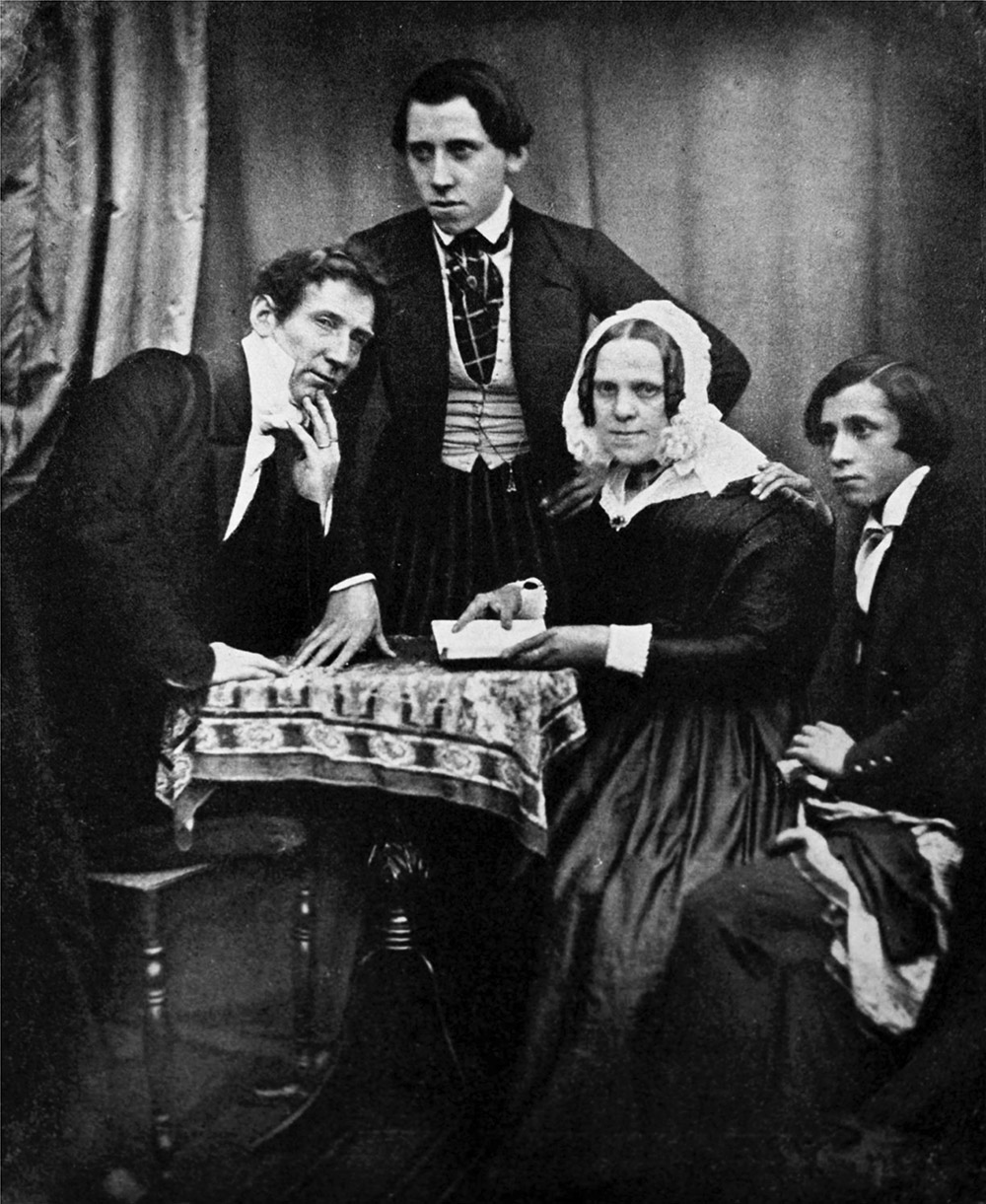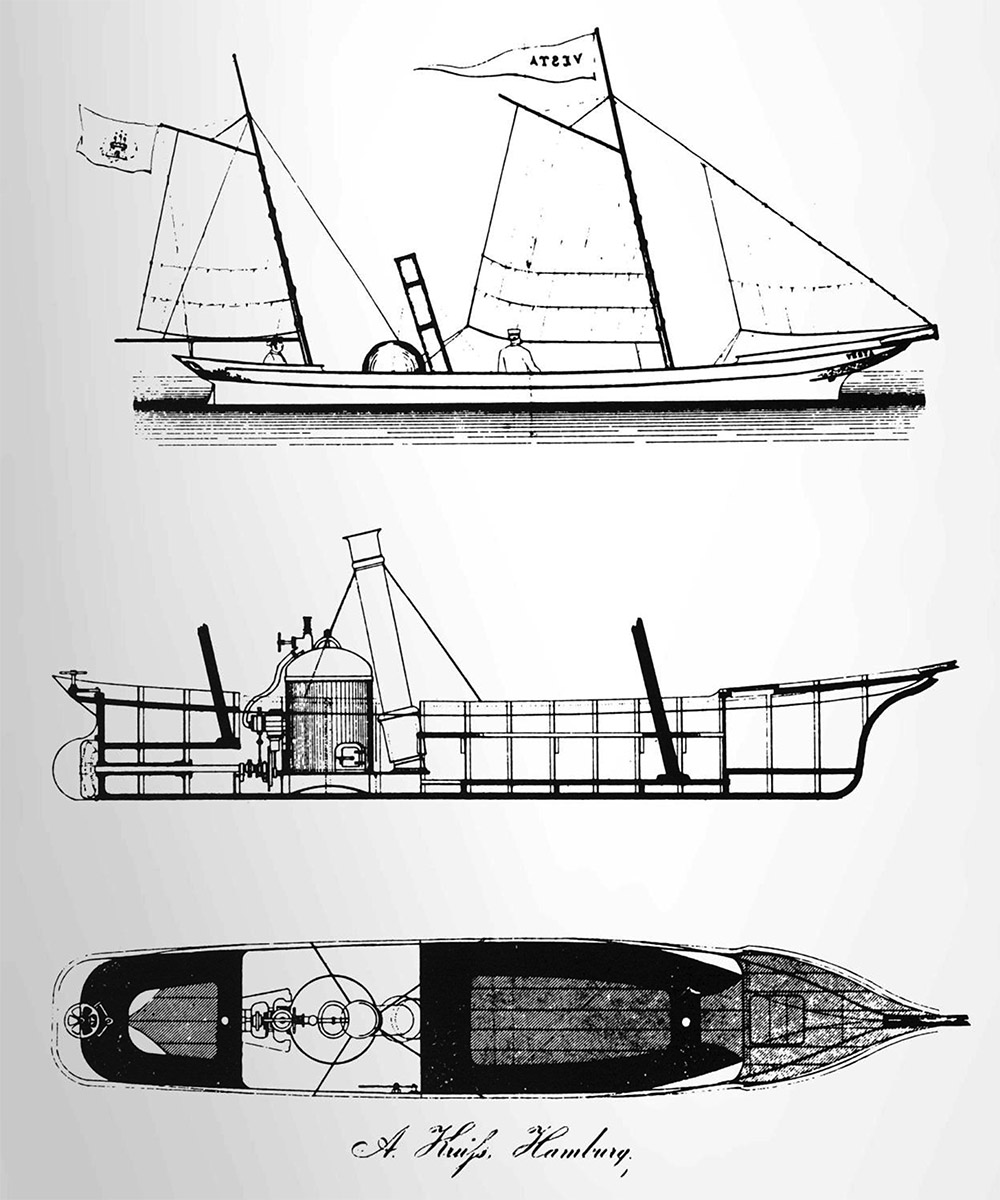A. Krüss
Edmund Gabory, ca. 1770 - 1813
Mary Ann Gabory Krüss, 1795 - 1858
Andres Krüss, 1791 - 1848
Edmund Johann Krüss, 1824 - 1906
William Andres Krüss, 1829 - 1909
Andres Hugo Krüss, 1853 - 1925
by Brian Stevenson
last updated July, 2023
The Hamburg, Germany scientific firm of A. Krüss traces its roots to 1790, when Edmund Gabory completed his apprenticeship in London, England with Jesse Ramsden (1735-1800). Gabory operated his own shop in London until 1796, then moved to Hamburg. After Gabory died in 1814, his son and daughter inherited the business. The daughter, Mary Ann, married Andres Krüss in 1823, who then joined his father-in-law’s optical, scientific, and engineering business.
Krüss and his brother-in-law, Edmund Nicolas Gabory, parted ways in 1844, with Krüss starting a new shop under his own name. Andres Krüss died of cholera in 1848, whereupon his widow ran the business until 1851, when their sons, Edmund and William, took control. The name “A. Krüss” was retained. A. Krüss has manufactured, and continues to make, a wide variety of scientific items, but this essay will focus on their early microscopes.
Advertisements indicate that A. Krüss was manufacturing microscopes in 1856, with the first being a drum-type instrument (Figures 1-4). Parisian manufacturer Georges Oberhaeuser popularized the drum-type microscope during the 1830-40s, so Krüss named their instrument the “Modell Oberhaeuser” (Figure 4). In 1859, Pieter Harting wrote that “Krüss in Hamburg … manufactures microscopes in the form of the small ‘microscopes coudés’ of Oberhäuser and of Schiek, at the unprecedentedly low price of 20 thalers … they are highly recommended for initial instruction and for the most common histological examinations, since they give a very clear magnification of 300 times, which is quite sufficient for many examinations. The mechanical setup is also quite good.”
Krüss evidently sold a fair number of these drum microscopes to retailers in France and the USA, who then re-sold them under their own names (Figures 3-4).
Later in the 1850s, Krüss introduced a “trichinoscope”, an open-fronted microscope with a triangular, clawed foot and a mirror that allowed for oblique illumination (Figures 5-6).
The firm of A. Krüss is still in business, manufacturing microscopes and other scientific apparatus.

Figure 1.
Three Krüss “Modell Oberhaeuser” microscopes. The drum-style instruments have draw-tube coarse focus, with fine focus consisting of a fine screw that adjusts the height of the stage. From left to right, the microscopes bear serial numbers 260, 191, and 131. From the author’s collection, or adapted by permission from http://www.antique-microscopes.com/photos/kruss.htm and https://www.musoptin.com/item/trommelmikroskop-a-kruess-191-um-1858 .

Figure 2.
Three identical microscopes, all undoubtedly manufactured by A. Krüss, ca. 1856-1860. Left to right, they are engraved with “A. Krüss”, “Maison Chevallier L’Ingéneur Queslin”, and unsigned but boxed with a label from Louis Mauss (ca.1829 - 1862), of Chicago. These and other examples indicate that Krüss sold microscopes wholesale, which were then re-sold by other retailers. From the author’s collection.

Figure 3.
A microscope that is nearly identical to the Krüss “Modell Oberhaeuser”. It is engraved "Richebourg à Paris", indicating sale by Pierre Ambroise Richebourg (1810-1875). Richebourg was trained by Vincent Chevalier (1770-1841), and took over Vincent’s shop after the elder man died. Richebourg primarily dealt with photographic equipment. Although a small number of microscopes are known that bear Richebourg’s name, their scarcity and inconsistent designs suggest that he occasionally acquired instruments from wholesale manufacturers and resold them, rather than having made them himself. My impression is that this microscope was produced by A. Krüss, with minor modifications from the “Modell Oberhaeuser”, including screwing the body into a boss on the case instead of onto a circular disc. Adapted for nonprofit, educational purposes from an internet auction site.

Figure 4.
Two advertisements for the Krüss “Modell Oberhaeuser”, from “Wiener Medizinische Wochenschrift” (1856) and “Allgemeine Zeitung München” (1858).

Figure 5.
A ca. 1860s Krüss “Trichinenmikroskop”. It bears serial number 1592. Adapted with permission from https://www.musoptin.com/item/trichinenmikroskop-a-kruess-1592-um-1865.

Figure 6.
Two advertisements for the Krüss “Trichinenmikroskop”, both from “Illustrirte Zeitung” (1859 and 1867).
Edmund Gabory was born in Strasbourg, Alsace. He completed his training and opened a shop in London during 1790, so if he had a standard apprenticeship, was probably born around 1770. Gabory married Mary Olby, and the pair had two children, Edmund Nicolas and Mary Ann. In 1796, Gabory moved the family and his shop to Hamburg.
Gabory’s home/business at 14 Neue Burg included a rooftop observatory, from which he conducted astronomical observations. He also gave public presentations on scientific topics, such as this on May 23, 1807: “Tomorrow, Sunday, the 24th of May, from 11-1 o`clock, Experimental Physics with a lecture on the most interesting effects of two large galvanic columns of unlike size with 80 plate pairs, the breaking down of water into its two elements and restoration of the same by means of an electric spark; application of common and galvanic electricity in the medical field, and more besides. Admission 1 Mark.”
Although Hamburg was technically a “Free and Hanseatic City”, the European wars of the early 1800s significantly disrupted trade. In December, 1810, Hamburg was annexed into Napoleon’s empire. While Gabory was issued a permit to continue his business, the history of the Krüss business notes that “All goods of British origin were confiscated and burnt. As a consequence, those valuable instruments and other articles that Gabory had acquired through his close ties with English manufacturers were also destroyed. The largest and best of his telescopes were requisitioned. Positioning them on the city towers, the French used these instruments to observe the surrounding area in order to obtain ample forewarning of any advancing enemy troops.”
On March 12, 1813, Hamburg was taken from the French by Russian Colonel von Tettenborn. Young Edmund Nicolas Gabory joined the “Hanseatic Legion” to aid with Hamburg’s liberation from Napoleon, but was badly wounded during fighting. Soon afterward, the French re-took Hamburg, putting Edmund Nicolas at risk of execution. He managed to avoid that fate, and was put to work by the French as a civil administrator.
Edmund Gabory died in early 1814. Son Edmund Nicolas and daughter Mary Ann inherited the family business.
Andres Krüss was born on March 21, 1796 on the Heligoland islands, off the coast of Denmark and then part of that country. As a youth, Krüss was involved with smuggling goods to Germany, bypassing the shipping blockades that took place during the war between England and Napoleonic France. In 1814, Heligoland was passed to England, and Krüss left for Hamburg. There, he opened a cigar shop with one of his brothers. He became a legal citizen of Hamburg at the beginning of October, 1823.
On October 12, 1823, Andres Krüss and Mary Ann Gabory were married. Andres then joined the Gabory business partnership. The pair had two children, Edmund and William, born in 1824 and 1828, respectively.
In November, 1844, Andres Krüss and Edmund Nicolas Gabory dissolved their partnership. Gabory continued his family business at the same location, while Krüss opened a shop under his own name on Alter Wall, Hamburg.
Hamburg was stricken by an outbreak of cholera in 1848. Andres Krüss was one of the victims, dying on October 25, 1848.
His widow, Mary Ann Krüss, continued management of the business until 1851, when she turned it over to sons Edmund and William. In that year, they moved the A. Krüss business to 7 Adolfsbrücke (Figure 9).
Edmund Krüss married Constance Bauer in May, 1852. His cousin, Alfred Gabory (heir to the Gabory business), married Constance’s sister, Elise. The eldest son of Edmund and Constance, Hugo, who would later inherit the A. Krüss business, was born on February 23, 1853.
Krüss won a first place medal at the 1855 Universal Exposition in Paris, for “a collossal barometer, the style of execution of which, does honor to its maker, Mr. Krüss.”
By 1856, Krüss was manufacturing drum-style microscopes, which they called the “Modell Oberhaeuser” (Figure 4). Advertisements stated that one could purchase a microscope with either one or two objective and ocular lenses, with an option for polarizing filters. Evidently, they produced these microscopes for their own retail and for the wholesale trade, distributing to dealers in Europe and the US (Figures 1-4).
An open-fronted, reclinable microscope on a triangular foot came into production by 1859 (Figure 5-6). An advantage of this design is that it allows sideways adjustment of the mirror, such that light can pass obliquely through the specimen. As Krüss advertised, “eine wesentliche Verbesserung in der Art erfahren, dass selbige mit einer Einrichtung zu der in vielen Fällen so wünschenswerthen schrägen Beleuchtung der Objecte versehen wurden” (“undergone an essential improvement in that they are capable of oblique illumination of objects, which is desirable in many cases.”) (Figure 6).
Around 1859, Krüss was commissioned to build a large model steamboat for the Prince of Siam. That inspired them to design boilers and small steamboats for use in coastal waters and lakes (Figure 11).
Krüss built a facility to grind photographic lenses in 1859. Their display of such lenses at the 1862 International Exhibition in London won a first place medal (Figure 12).
In 1874, William Krüss left the partnership. Edmund’s son, Hugo, then joined his father as a partner of A. Krüss. A few years later, in 1886, Alfred Gabory sold his business to Krüss, reuniting the branches of Edmund Gabory’s original Hamburg business.
Edmund Krüss retired in 1888, leaving son Hugo in control. Hugo was widely educated, having trained in the optical-mechanical workshop of Dennert & Pape, Hamburg, and the optical-astronomical workshop of C.A. Steinheil & Söhne in Munich, and received a Ph.D. from the University of Munich. Hugo managed the business until 1920, then turned it over to his son, Paul. Further descendants have continued operations of A. Krüss until this day.

Figure 7.
The Krüss family in 1845 (left to right) Andres, Edmund, Mary Ann, and William. Adapted for nonprofit, educational purposes from “The History of a Hamburg-Based Family Company”.

Figure 8.
Edmund and William Krüss purchased this building at 7 Adolfsbrücke, Hamburg in 1851. It was the home of the A. Krüss until 1920. Adapted for nonprofit, educational purposes from “The History of a Hamburg-Based Family Company”.


Figure 9.
(Top) Stereograph of Edmund Krüss. He is holding a “Modell Oberhaueser” microscope. (Bottom) Enlargement of the microscope. From https://commons.wikimedia.org/wiki/File:Kr%C3%BCss,_Andreas_-_Portr%C3%A4t_Edmund_Johann_Kr%C3%BCss_(Zeno_Fotografie).jpg

Figure 10.
An 1857 advertisement for Krüss magic lantern projectors, from “Illustrirte Zeitung”.

Figure 11.
ca. 1859 designs for a small steamboat. Adapted for nonprofit, educational purposes from “The History of a Hamburg-Based Family Company”.

Figure 12.
An 1865 advertisement for Krüss photographic apparatus, from “Photographische Monatshefte”.

Figure 13.
ca. 1865 binoculars by A. Krüss. Adapted for nonprofit, educational purposes from “The History of a Hamburg-Based Family Company”.

Figure 14.
Stereoview of Steinstraße, Hamburg, blindstamped "A Krüss, Hamburg", ca. 1860-1880. Adapted for nonprofit, educational purposes from an internet auction site.

Figure 15.
Spectroscope by A Krüss. Adapted for nonprofit, educational purposes from an internet auction site.

Figure 16.
Portrait of Hugo Krüss. Adapted for nonprofit, educational purposes from “The History of a Hamburg-Based Family Company”.
Resources
Allgemeine Zeitung München (1858) Advertisements from A. Krüss
Birth record of Edmund Nicholas Gabory (1793) Parish records of St. Andrew Holborn, accessed through ancestry.com
Birth record of Mary Ann Gabory (1795) Parish records of St. Andrew Holborn, accessed through ancestry.com
Canada at the Universal Exhibition of 1855 (1855) pages 270-271
Fremden-Blatt (1856) Advertisements from A. Krüss
Hager, Hermann (1866) Das Mikroskop und Seine Anwendung, Springer, Berlin, Advertisement from A. Krüss
Illustrirte Zeitung (1857) Advertisements from A. Krüss
Illustrirte Zeitung (1859) Advertisements from A. Krüss
Illustrirte Zeitung (1867) Advertisements from A. Krüss
Harting, Pieter (1859) Das Mikroskop, F. Vieweg und Sohn, Braunschweig, page 741
A. Krüss Optronic Gmbh (2021) The History of a Hamburg-based Family Company, accessed June, 2023, https://www.kruess.com/en/company/aboutus/
Photographische Monatshefte (1865) Advertisements from A. Krüss
Reinicke, Friedrich (1858) Beitraege zur Neuern Mikroskopie, Vol. 1, page 65, Advertisement from A. Krüss
Wiener Medizinische Wochenschrift (1856) Advertisement from A. Krüss, Vol. 6, page 527
















